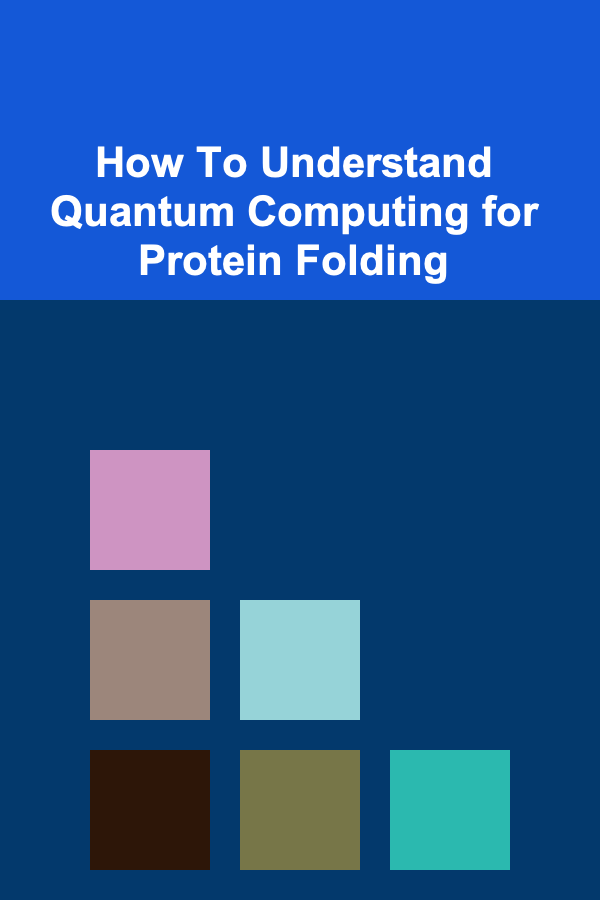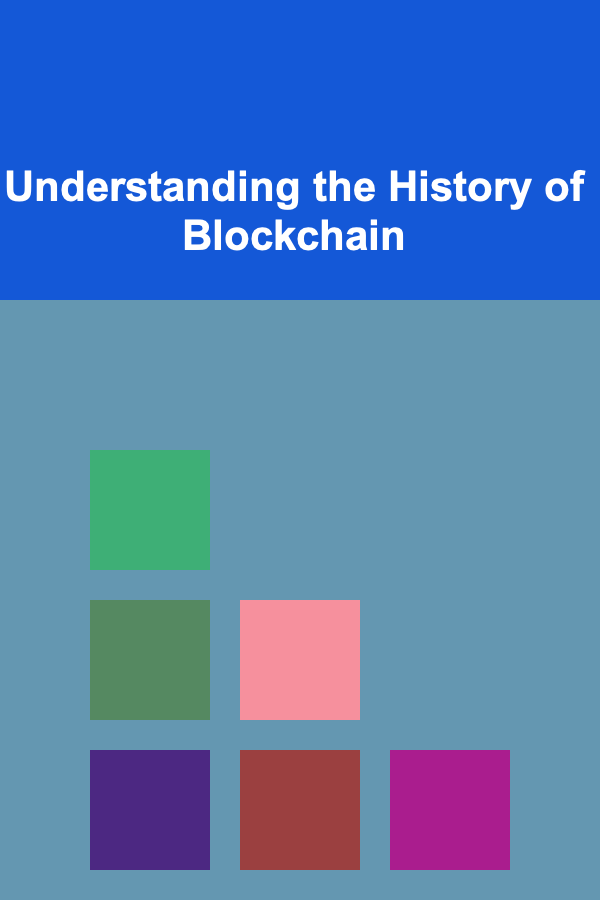
How To Understand Quantum Computing for Protein Folding
ebook include PDF & Audio bundle (Micro Guide)
$12.99$10.99
Limited Time Offer! Order within the next:

Quantum computing is one of the most revolutionary fields in modern science and technology. It promises to solve complex problems that classical computers cannot, including those in areas such as cryptography, artificial intelligence, and drug discovery. One of the most exciting applications of quantum computing is in the realm of protein folding, a crucial process in biology that impacts everything from disease understanding to drug design. In this article, we will explore how quantum computing could transform our ability to understand and predict protein folding, a fundamental aspect of life sciences.
The Science of Protein Folding
Before we dive into quantum computing, it's essential to understand what protein folding is and why it's so significant in biological systems.
What Is Protein Folding?
Proteins are large, complex molecules that play many critical roles in the body. They are made up of chains of amino acids, which fold into intricate three-dimensional shapes. The sequence of amino acids in a protein dictates its final structure, and that structure, in turn, determines its function.
Protein folding is the process by which a linear chain of amino acids folds into a specific, functional three-dimensional structure. This process is crucial because the function of a protein is determined by its shape. If the protein folds incorrectly, it may lead to diseases such as Alzheimer's, Parkinson's, and cystic fibrosis.
Why Protein Folding Is Challenging
Understanding protein folding is a complex and multifaceted challenge. Proteins can fold into an almost infinite number of configurations due to the vast number of possible amino acid arrangements. The folding process itself is influenced by a variety of factors, including temperature, pH, and ionic strength. Given the immense number of variables at play, predicting the final folded structure from a sequence of amino acids has proven to be computationally intractable for classical computers.
Classical approaches to protein folding rely on computational simulations and models that try to predict how a protein will fold. These simulations often take a long time and require vast amounts of computational power. While they have made progress, they still fall short when it comes to solving the most complex protein folding problems.
Enter Quantum Computing
Quantum computing is a rapidly developing field that leverages the principles of quantum mechanics, which governs the behavior of particles at extremely small scales. Unlike classical computers, which process information in binary (0s and 1s), quantum computers use quantum bits or qubits. These qubits can exist in multiple states simultaneously, thanks to a property known as superposition. Additionally, qubits can be entangled, meaning the state of one qubit can depend on the state of another, even if they are far apart.
The ability to process information in parallel, combined with quantum entanglement, gives quantum computers a significant advantage over classical computers when it comes to solving certain types of complex problems.
Quantum Computing and Protein Folding
Protein folding involves a massive search space due to the numerous possible configurations a protein can adopt. Classical computers struggle with this because they process information sequentially, evaluating each possibility one by one. In contrast, quantum computers, with their ability to explore multiple possibilities simultaneously, are well-suited to the task of protein folding.
Let's break down how quantum computing could help in protein folding.
1. Superposition and Parallel Processing
Quantum computers have the ability to perform many calculations simultaneously thanks to superposition. A classical computer would need to evaluate each potential folding configuration of a protein one by one. However, a quantum computer could, in theory, examine many configurations at the same time. This would dramatically speed up the process of predicting how a protein will fold, which is critical in drug discovery and disease treatment.
2. Quantum Entanglement and Correlation
In protein folding, the interactions between amino acids play a crucial role in determining the final shape of the protein. These interactions are highly complex and involve both local and global correlations. Quantum entanglement allows for the creation of correlations between qubits in a quantum computer. This property could help model the intricate interactions between amino acids and how they influence protein folding.
3. Quantum Algorithms for Optimization
One of the significant challenges in protein folding is finding the optimal folded structure from an enormous search space. Classical optimization algorithms, such as gradient descent, can be used to search through potential solutions, but they often get stuck in local minima, failing to find the global minimum (the most stable configuration). Quantum computing has the potential to overcome this limitation through algorithms designed to explore the search space more efficiently.
For example, the quantum approximate optimization algorithm (QAOA) is a quantum algorithm that can be used to solve combinatorial optimization problems. It has the potential to outperform classical methods in protein folding by finding better solutions faster and avoiding local minima traps.
Challenges in Quantum Computing for Protein Folding
While the promise of quantum computing in protein folding is exciting, it is not without its challenges. Quantum computers are still in the early stages of development, and there are several hurdles that must be overcome before they can be applied to problems like protein folding on a large scale.
1. Noisy Intermediate-Scale Quantum (NISQ) Devices
Currently, most quantum computers are in the NISQ era. These devices are still too small and noisy to handle large-scale problems like protein folding effectively. Quantum computers are highly sensitive to noise and interference, which can lead to errors in calculations. Until we have more stable and scalable quantum computers, applying them to protein folding on a practical level will remain difficult.
2. Scalability
The number of qubits required to simulate a large protein is enormous. As proteins grow larger and more complex, the computational power needed to model their folding increases exponentially. Although quantum computers have the potential to solve problems that classical computers cannot, it will take significant advancements in quantum hardware and algorithms to scale up to the level required for complex protein folding.
3. Algorithm Development
While quantum computing holds great promise, the algorithms required to solve protein folding problems are still being developed. Quantum algorithms for protein folding are in the early stages, and much work remains to be done before they can be applied effectively to real-world problems. Researchers are actively working on developing algorithms that are specifically tailored to quantum computing's strengths.
Current Research and Developments
Despite the challenges, progress is being made in applying quantum computing to protein folding. Several research groups and companies are actively exploring how quantum computers can be used to simulate protein folding and solve related problems.
1. IBM and the Quantum Computing Landscape
IBM is one of the leaders in quantum computing and has made significant strides in developing quantum algorithms for protein folding. The company's quantum computing platform, IBM Quantum, is being used by researchers to explore the potential of quantum computing in biology and chemistry. IBM has also developed the Qiskit framework, which allows researchers to experiment with quantum algorithms for protein folding and other molecular simulations.
2. Google and Quantum Supremacy
Google has made headlines with its achievement of quantum supremacy, the point at which a quantum computer can solve a problem that classical computers cannot. While Google's Sycamore quantum processor has not yet been applied to protein folding, it represents an important step toward realizing the full potential of quantum computing in the life sciences.
3. Quantum Simulations in Drug Discovery
One of the most promising applications of quantum computing for protein folding is in drug discovery. By simulating how proteins fold and how they interact with potential drug molecules, quantum computers could accelerate the development of new treatments for diseases. Researchers are already using quantum computers to simulate small proteins and explore how they bind to drug candidates.
The Future of Quantum Computing in Protein Folding
The intersection of quantum computing and protein folding is still in its early stages, but the future looks promising. As quantum hardware improves and quantum algorithms become more refined, we are likely to see significant breakthroughs in our understanding of protein folding and its role in disease and drug discovery.
In the coming years, we can expect to see several developments in this area:
- Increased Quantum Computer Power: As quantum computers become more powerful and stable, they will be able to handle larger and more complex protein folding problems.
- Advancements in Quantum Algorithms: Researchers will continue to develop algorithms that are specifically designed for protein folding, enabling more efficient and accurate simulations.
- Collaborations Between Industry and Academia: The collaboration between tech companies like IBM and Google and academic institutions will lead to rapid advancements in the field of quantum computing for protein folding.
- Practical Applications in Medicine: Eventually, quantum computers could be used to design new drugs and therapies by simulating protein folding and predicting how drugs will interact with specific proteins. This could revolutionize the pharmaceutical industry.
Conclusion
Quantum computing holds immense promise for revolutionizing the field of protein folding. By leveraging the unique properties of quantum mechanics, quantum computers can explore vast and complex search spaces more efficiently than classical computers. While significant challenges remain, progress in quantum computing is accelerating, and we are on the verge of breakthroughs that could transform our understanding of biology and medicine. The potential applications in drug discovery, disease understanding, and personalized medicine are vast, and as quantum computing technology continues to evolve, it may soon become a cornerstone of biochemistry and molecular biology.

How to Build a Passive Income Stream Through Real Estate Investment
Read More
How to Choose the Best Neighborhood Watch Program for Your Area
Read More
How To Handle Customer Complaints Gracefully
Read More
How To Choose the Best Eyeshadow Palette for Your Eye Color
Read More
Understanding the History of Blockchain
Read More
How to Dial in Espresso for Different Bean Origins
Read MoreOther Products

How to Build a Passive Income Stream Through Real Estate Investment
Read More
How to Choose the Best Neighborhood Watch Program for Your Area
Read More
How To Handle Customer Complaints Gracefully
Read More
How To Choose the Best Eyeshadow Palette for Your Eye Color
Read More
Understanding the History of Blockchain
Read More